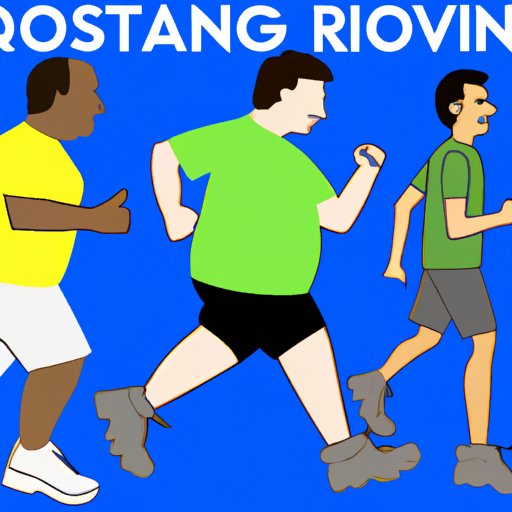Introduction
For those who are overweight, running can seem like an impossible goal. But it doesn’t have to be. With the right approach and guidance, anyone can start running and reap the many physical and mental health benefits of this form of exercise.
This article will explore the steps that overweight individuals should take in order to begin running safely and successfully. We’ll look at how to get started, monitor your progress, set realistic goals, find the right gear, incorporate strength training, and seek medical advice. Let’s get started!
Start with Walking
If you’re overweight, trying to jump straight into running can lead to injury or other health complications. It’s important to ease into the process by starting with walking. According to a study published in the American Journal of Preventive Medicine, “Walking is an effective way to reduce body fat, improve cardiorespiratory fitness, and reduce risk factors for chronic diseases.”
When beginning your walking routine, start slowly. Aim for 10-15 minutes per day, gradually increasing the duration and intensity over time. You can also break up your walking sessions throughout the day if that works best for your schedule.
Monitor Your Progress
It’s important to track your progress as you start running. This can help you stay motivated and on track with your goals. You can use a variety of methods to do this, including wearable devices, apps, and journals.
For example, the Nike+ Run Club app allows you to track your runs, set goals, and share your progress with friends. If you prefer something a bit more low-tech, consider keeping a running log where you record details like distance, pace, and time.
Set Realistic Goals
Setting realistic goals is key when you’re just starting out. Don’t try to push yourself too hard—it’s much better to start slow and work your way up. Start by aiming for short distances and gradually increase them over time. Trying to do too much too soon can lead to injury and burnout.
It’s also important to focus on your overall health and wellbeing, not just on numbers like weight or calories burned. Celebrate small victories and don’t be afraid to give yourself a pat on the back. As Dr. Jordan Metzl, a sports medicine physician at New York City’s Hospital for Special Surgery, explains, “The most important thing is to enjoy the process.”
Find the Right Gear
Having the right gear can make all the difference when it comes to running. You’ll need supportive shoes, comfortable clothing, and maybe even a hat or sunglasses to shield you from the sun. If you’re running outdoors, you may also want to invest in a GPS watch or tracker.
When selecting your gear, it’s important to find items that are both comfortable and supportive. Look for shoes that provide adequate cushioning and support. And make sure your clothing is made of breathable, moisture-wicking fabric.
Incorporate Strength Training
Strength training is an important part of any running program. Working on your core and leg muscles will help you become a stronger, more efficient runner. It can also help prevent injuries and boost your confidence.
Focus on exercises that target your glutes, quads, hamstrings, and calves. Squats, lunges, and step-ups are all great options. You can also incorporate upper-body exercises like push-ups and rows to strengthen your arms and back.
Seek Medical Advice
Before starting any exercise program, it’s important to consult your doctor. They can help you determine if running is the right activity for you and provide advice on how to stay safe while running.
Be sure to ask your doctor about any medications you’re taking and any underlying health conditions you may have. They can also provide recommendations on activities that may be better suited to your individual needs.
Conclusion
Running can be intimidating for those who are overweight, but it’s important to remember that anyone can do it. Start by incorporating walking into your daily routine, then move on to setting realistic goals, monitoring your progress, finding the right gear, and incorporating strength training. And don’t forget to consult your doctor before getting started.
With the right approach and guidance, you can achieve your running goals and experience the many physical and mental health benefits that come along with it.
(Note: Is this article not meeting your expectations? Do you have knowledge or insights to share? Unlock new opportunities and expand your reach by joining our authors team. Click Registration to join us and share your expertise with our readers.)
